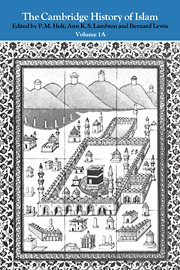Book contents
- Frontmatter
- Introduction
- Part I The rise and domination of the Arabs
- Part II The coming of the steppe peoples
- Part III The central Islamic lands in the Ottoman period
- 1 The rise of the Ottoman empire
- 2 The heyday and decline of the Ottoman empire
- 3 The later Ottoman empire in Rumelia and Anatolia
- 4 The later Ottoman empire in Egypt and the fertile crescent
- 5 Safavid Persia
- 6 Persia: the breakdown of society
- 7 Central Asia from the sixteenth century to the Russian conquests
- Appendix The Golden Horde and its successors
- 8 Tsarist Russia and the Muslims of central Asia
5 - Safavid Persia
from Part III - The central Islamic lands in the Ottoman period
Published online by Cambridge University Press: 28 March 2008
- Frontmatter
- Introduction
- Part I The rise and domination of the Arabs
- Part II The coming of the steppe peoples
- Part III The central Islamic lands in the Ottoman period
- 1 The rise of the Ottoman empire
- 2 The heyday and decline of the Ottoman empire
- 3 The later Ottoman empire in Rumelia and Anatolia
- 4 The later Ottoman empire in Egypt and the fertile crescent
- 5 Safavid Persia
- 6 Persia: the breakdown of society
- 7 Central Asia from the sixteenth century to the Russian conquests
- Appendix The Golden Horde and its successors
- 8 Tsarist Russia and the Muslims of central Asia
Summary
Despite recent research, the origins of the Safavid family are still obscure. Such evidence as we have seems to suggest that the family hailed from Kurdistān. What does seem certain is that the Safavids were of native Iranian stock, and spoke Āzarī, the form of Turkish used in Āzarbāyjān. Our lack of reliable information derives from the fact that the Safavids, after the establishment of the Safavid state, deliberately falsified the evidence of their own origins. Their fundamental object in claiming a Shi‘ī origin was to differentiate themselves from the Ottomans and to enable them to enlist the sympathies of all heterodox elements. To this end they systematically destroyed any evidence which indicated that Shaykh Safī al-Dīn Ishāq, the founder of the Safavid tarīqa was not a Shī‘ī (he was probably a Sunnī of the Shāfi‘ī madhhab), and they fabricated evidence to prove that the Safavids were sayyids, that is, direct descendants of the Prophet. They constructed a dubious genealogy tracing the descent of the Safavid family from the seventh of the Twelver Imāms, Mūsā al-Kāzim—a genealogy which is seduously followed by the later Safavid sources—and introduced into the text of a hagiological work on the life of Shaykh Safī al-Dīn, a number of anecdotes designed to validate the Safavid claim to be sayyids. Viewed dispassionately, the majority of these anecdotes appear ingenuous, not to say naïve.
- Type
- Chapter
- Information
- The Cambridge History of Islam , pp. 394 - 429Publisher: Cambridge University PressPrint publication year: 1977
- 1
- Cited by

